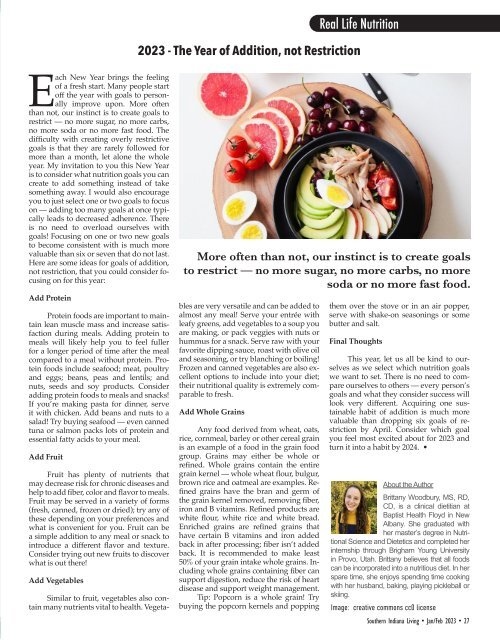Southern Indiana Living Magazine - Jan / Feb 2023
January / February 2023 issue of SIL
January / February 2023 issue of SIL
- No tags were found...
Create successful ePaper yourself
Turn your PDF publications into a flip-book with our unique Google optimized e-Paper software.
Real Life Nutrition<br />
<strong>2023</strong> - The Year of Addition, not Restriction<br />
Each New Year brings the feeling<br />
of a fresh start. Many people start<br />
off the year with goals to personally<br />
improve upon. More often<br />
than not, our instinct is to create goals to<br />
restrict — no more sugar, no more carbs,<br />
no more soda or no more fast food. The<br />
difficulty with creating overly restrictive<br />
goals is that they are rarely followed for<br />
more than a month, let alone the whole<br />
year. My invitation to you this New Year<br />
is to consider what nutrition goals you can<br />
create to add something instead of take<br />
something away. I would also encourage<br />
you to just select one or two goals to focus<br />
on — adding too many goals at once typically<br />
leads to decreased adherence. There<br />
is no need to overload ourselves with<br />
goals! Focusing on one or two new goals<br />
to become consistent with is much more<br />
valuable than six or seven that do not last.<br />
Here are some ideas for goals of addition,<br />
not restriction, that you could consider focusing<br />
on for this year:<br />
Add Protein<br />
Protein foods are important to maintain<br />
lean muscle mass and increase satisfaction<br />
during meals. Adding protein to<br />
meals will likely help you to feel fuller<br />
for a longer period of time after the meal<br />
compared to a meal without protein. Protein<br />
foods include seafood; meat, poultry<br />
and eggs; beans, peas and lentils; and<br />
nuts, seeds and soy products. Consider<br />
adding protein foods to meals and snacks!<br />
If you’re making pasta for dinner, serve<br />
it with chicken. Add beans and nuts to a<br />
salad! Try buying seafood — even canned<br />
tuna or salmon packs lots of protein and<br />
essential fatty acids to your meal.<br />
Add Fruit<br />
Fruit has plenty of nutrients that<br />
may decrease risk for chronic diseases and<br />
help to add fiber, color and flavor to meals.<br />
Fruit may be served in a variety of forms<br />
(fresh, canned, frozen or dried); try any of<br />
these depending on your preferences and<br />
what is convenient for you. Fruit can be<br />
a simple addition to any meal or snack to<br />
introduce a different flavor and texture.<br />
Consider trying out new fruits to discover<br />
what is out there!<br />
Add Vegetables<br />
More often than not, our instinct is to create goals<br />
to restrict — no more sugar, no more carbs, no more<br />
soda or no more fast food.<br />
Similar to fruit, vegetables also contain<br />
many nutrients vital to health. Vegetables<br />
are very versatile and can be added to<br />
almost any meal! Serve your entrée with<br />
leafy greens, add vegetables to a soup you<br />
are making, or pack veggies with nuts or<br />
hummus for a snack. Serve raw with your<br />
favorite dipping sauce, roast with olive oil<br />
and seasoning, or try blanching or boiling!<br />
Frozen and canned vegetables are also excellent<br />
options to include into your diet;<br />
their nutritional quality is extremely comparable<br />
to fresh.<br />
Add Whole Grains<br />
Any food derived from wheat, oats,<br />
rice, cornmeal, barley or other cereal grain<br />
is an example of a food in the grain food<br />
group. Grains may either be whole or<br />
refined. Whole grains contain the entire<br />
grain kernel — whole wheat flour, bulgur,<br />
brown rice and oatmeal are examples. Refined<br />
grains have the bran and germ of<br />
the grain kernel removed, removing fiber,<br />
iron and B vitamins. Refined products are<br />
white flour, white rice and white bread.<br />
Enriched grains are refined grains that<br />
have certain B vitamins and iron added<br />
back in after processing; fiber isn’t added<br />
back. It is recommended to make least<br />
50% of your grain intake whole grains. Including<br />
whole grains containing fiber can<br />
support digestion, reduce the risk of heart<br />
disease and support weight management.<br />
Tip: Popcorn is a whole grain! Try<br />
buying the popcorn kernels and popping<br />
them over the stove or in an air popper,<br />
serve with shake-on seasonings or some<br />
butter and salt.<br />
Final Thoughts<br />
This year, let us all be kind to ourselves<br />
as we select which nutrition goals<br />
we want to set. There is no need to compare<br />
ourselves to others — every person’s<br />
goals and what they consider success will<br />
look very different. Acquiring one sustainable<br />
habit of addition is much more<br />
valuable than dropping six goals of restriction<br />
by April. Consider which goal<br />
you feel most excited about for <strong>2023</strong> and<br />
turn it into a habit by 2024. •<br />
About the Author<br />
Brittany Woodbury, MS, RD,<br />
CD, is a clinical dietitian at<br />
Baptist Health Floyd in New<br />
Albany. She graduated with<br />
her master’s degree in Nutritional<br />
Science and Dietetics and completed her<br />
internship through Brigham Young University<br />
in Provo, Utah. Brittany believes that all foods<br />
can be incorporated into a nutritious diet. In her<br />
spare time, she enjoys spending time cooking<br />
with her husband, baking, playing pickleball or<br />
skiing.<br />
Image: creative commons cc0 license<br />
<strong>Southern</strong> <strong>Indiana</strong> <strong>Living</strong> • <strong>Jan</strong>/<strong>Feb</strong> <strong>2023</strong> • 27
















